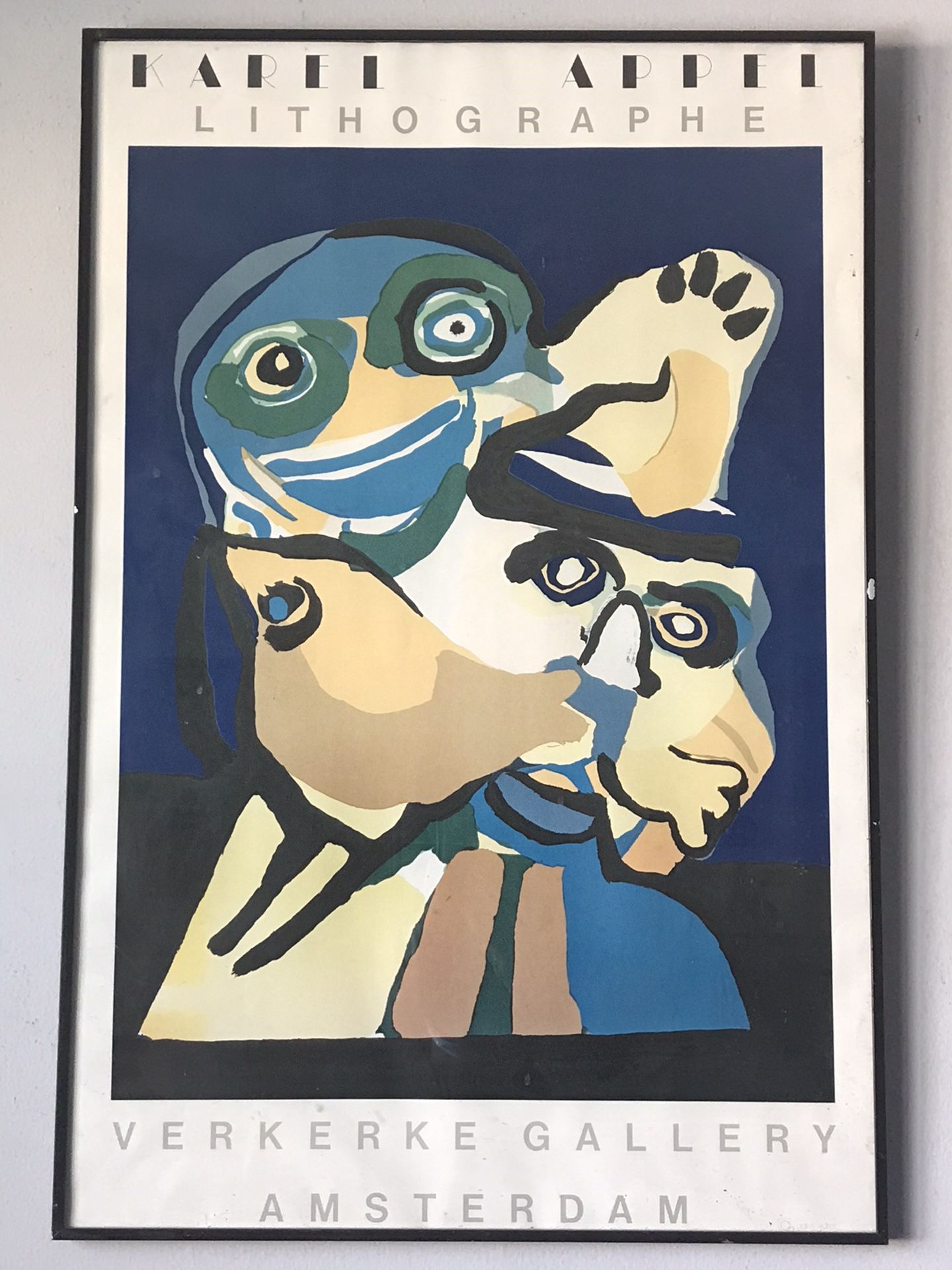KAREL APPEL EXHIBITION LITHOGRAPH POSTER - MODERN ABSTRACT CUBIST CUBISM VINTAGE
$500
Ships for $18.5
Posted almost 5 years ago in Pasadena, CA
Condition: Used (normal wear)
Listed in categories: Collectibles & Art - Arts & Crafts supplies
Chat securely on the app
Sold by
2-Day Purchase Protection
Items shipped through OfferUp come with a 2-day purchase protection.

Additional images
Description
KAREL APPEL (Dutch 1921-2006) MEDIUM: LITHOGRAPH EXHIBITION POSTER. VERKERKE GLLERY , AMSTERDAM 1984 GOOD VINTAGE CONDITION. DIMENSIONS: 36”H x 24”W Biography Across a nearly six-decade career, Karel Appel (b. 1921, Amsterdam, Netherlands; d. 2006, Zürich, Switzerland) established a distinct aesthetic that made him one of the most influential Dutch artists in the latter half of the twentieth century. Born Christiaan Karel Appel in 1921 to a working-class family in Amsterdam, he was artistic from an early age. In the shadow of the Second World War, Appel forged a new artistic path by combining the modern aesthetic with a spontaneous approach to composition and vibrant fields of color. 1948 became a pivotal year for the artist, meeting and joining forces with creative collaborators throughout Europe. Prompted by the artist Constant, the collective Dutch Experimental Group was formed, including Appel as well as Corneille and others. Just four months later, Appel, Constant, Corneille, Christian Dotremont, Asger Jorn and Joseph Noiret would found CoBrA, an essential postwar movement named for the home cities Copenhagen, Brussels, and Amsterdam. In 1949, Appel became a household name in the Netherlands over a controversy regarding his large-scale mural in the cafeteria of Amsterdam’s city hall, painted with an aesthetic inspired by children’s drawings entitled Questioning Children. Appel’s mural was met with massive protest and subsequently covered with wallpaper. Soon thereafter in 1950, the draw of avant-garde circles in Paris encouraged Appel to leave the Netherlands. Appel drew his earliest inspiration from folk art, children’s drawings, and the works of the mentally ill. In 1950, the artist finished work on his Psychopathological Notebook (1948-50), a series of drawings layered atop a text-based catalogue for an exhibition of artwork by the mentally ill at the Saint-Anne Hospital in Paris. Visiting this exhibition on multiple occasions proved impactful for Appel and would inform much of his work in the following years. At the suggestion of French critic Michel Tapié, Appel met gallerist Martha Jackson, who would give the artist his first one-person show in New York City in 1954 and continue to show his work for the next twenty years. During his time in New York in the late 1950s, Appel became friendly with Sam Francis, fellow-Dutchman Willem de Kooning, Franz Kline, and other members of the Abstract Expressionist group, as well as Jazz luminaries Dizzy Gillespie, Miles Davis, Count Basie, and Sarah Vaughan. This circle of cultural producers was sympathetic to Appel’s interest in the immediacy of painterly expression on canvas and would influence the artist’s painting style, oscillating as it were between realism and an emotionally charged, robustly active, and spontaneous abstraction. He traveled widely in subsequent decades and continued to produce work prolifically, venturing into musical composition, poetry, assemblage sculptures, as well as experimental work in ceramics. Appel spent much of the following half-century moving between New York and Europe. During his lifetime, the artist would participate in numerous one-person traveling exhibitions around the world and would represent the Netherlands in the 27th International Art Exhibition in the Venice Biennale. Appel’s work is represented in public collections internationally, including the Albertina Museum, Vienna, Austria; Art Gallery of Ontario, Toronto, Canada; Fondation Vincent Van Gogh, Arles, France; Hirshhorn Museum and Sculpture Garden, Washington D.C.; Louisiana Museum of Modern Art, Humlebaek, Denmark; Moderna Museet, Stockholm, Sweden; Musée d’Art Modern et d’Art Contemporain, Liége, Belgium; Musée d'Art Moderne de la Ville de Paris, France, Musée National d’Art Moderne, Centre Georges Pompidou, Paris, France; Museo de Arte Moderno, Mexico City, Mexico; Museu de Arte de São Paulo Assis Chateaubriand, São Paulo, Brazil; Museum of Fine Arts, Boston, MA; Museum of Modern Art, New York, NY; National Gallery of Canada, Ottawa, Canada; National Museum of Art, Architecture and Design, Oslo, Norway; The Phillips Collection, Washington, D.C.; Pinakothek der Moderne, Munich, Germany; San Francisco Museum of Modern Art, San Francisco, CA; Solomon R. Guggenheim Museum, New York, NY; Tate Modern, London, UK; and the Tel Aviv Museum of Art, Tel Aviv, Israel; and of course in all major Dutch museums, in particular the Rijksmuseum, Amsterdam; Stedelijk Museum, Amsterdam; and the Gemeentemuseum Den Haag, The Hague. Mid century modern abstract painting Picasso Matisse miro hockney Dali
Take action
Item location map
Map is approximate to keep seller’s location private.
Related searches
- Wedding dress
- Wedding rings
- Flower girl dresses